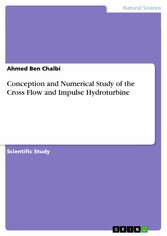Suchen und Finden
Conception and Numerical Study of the Cross Flow and Impulse Hydroturbine
Scientific Study from the year 2018 in the subject Physics - Mechanics, grade: Cfd program ansys CFX, , course: ingénierie en électromécanique, language: English, abstract: Energy is one of the most major fields in the development of a society and its economy. Its consummations rate could by the way be an indicator of the level of prosperity that a nation could achieve. Among renewable sources of energies, hydro power is an important source of environmental-friendly energy and has become more and more important in the recent years. Water energy, as a renewable source of energy, can help in reducing the dependency on fossil fuels. The number of installed water power systems is increasing every year and many nations have made plans to make large investments in hydropower in the near future. Many developed and developing countries have realized the importance of water as an important resource for power generation and necessary measures are being taken up across the globe to tap this energy for its effective utilization in power production. Remarkable advances in water turbines design have been possible due to developments in modern technology. In this context, we are interested in developing a design and a numerical study of the Impulse and the Cross flow hydro turbine's type. This book contains four chapters; in the first, a bibliographic study has been developed in order to present a general view about renewable energy, hydropower and different ways to gather it. A particular interest has been given to the water rotors concerning their different types and historical of some famous type like cross flow and Impulse turbines type, object of our study. Indeed, the bibliographic study summarized the considered parameters to improve the water turbine performances. The second chapter presents the numerical approach developed using the CFD code 'CFX'. I present also the mathematical formulation and the turbulence model will be presented. Then a background of the used methods in our numerical model will be undertaken. The third chapter presents the numerical simulations consisting on the characterization of the hydro dynamic structure of the impulse and the cross flow turbines The fourth chapter consist of the design of the test bench and the different components and solutions.
Alle Preise verstehen sich inklusive der gesetzlichen MwSt.







